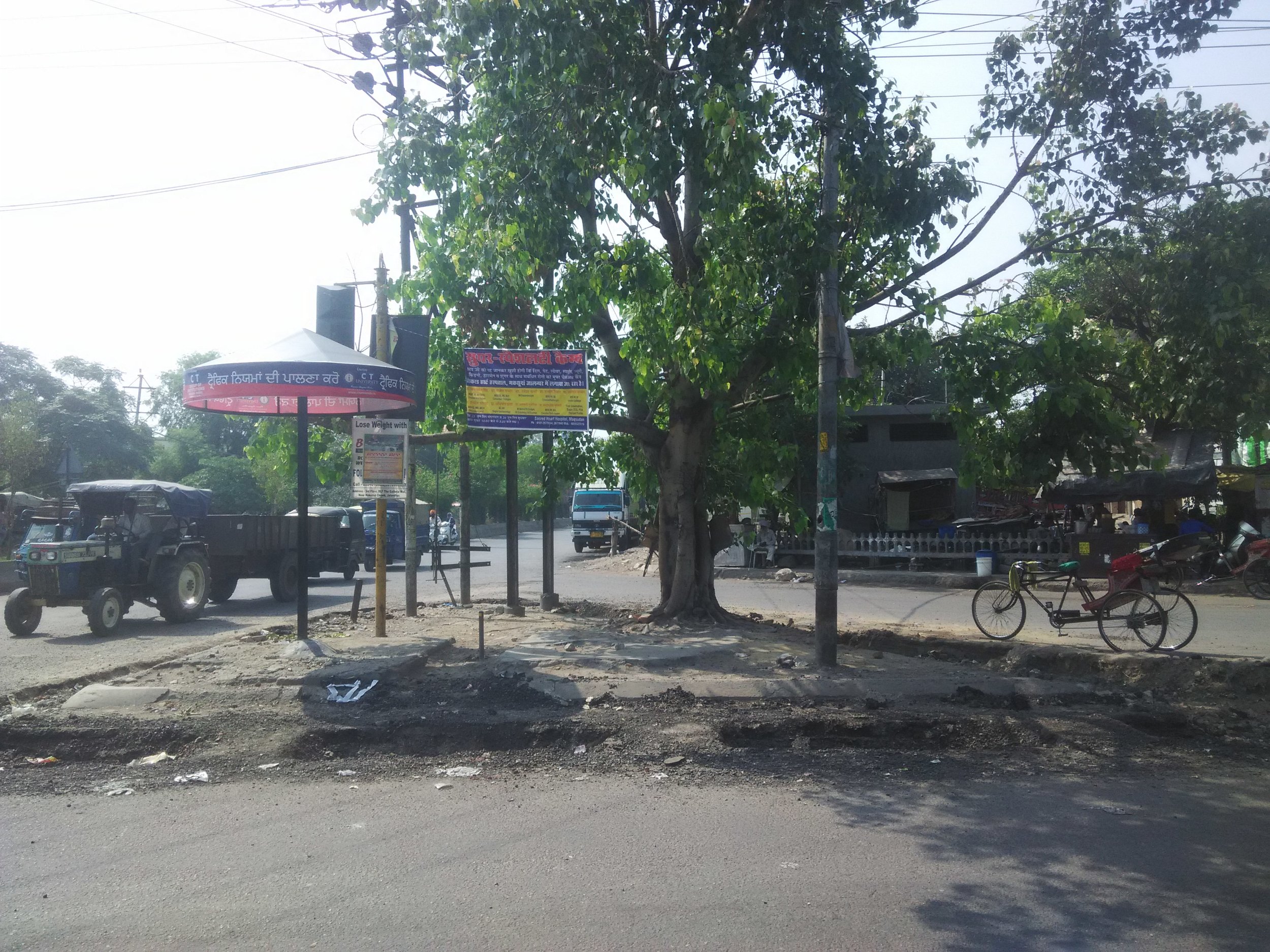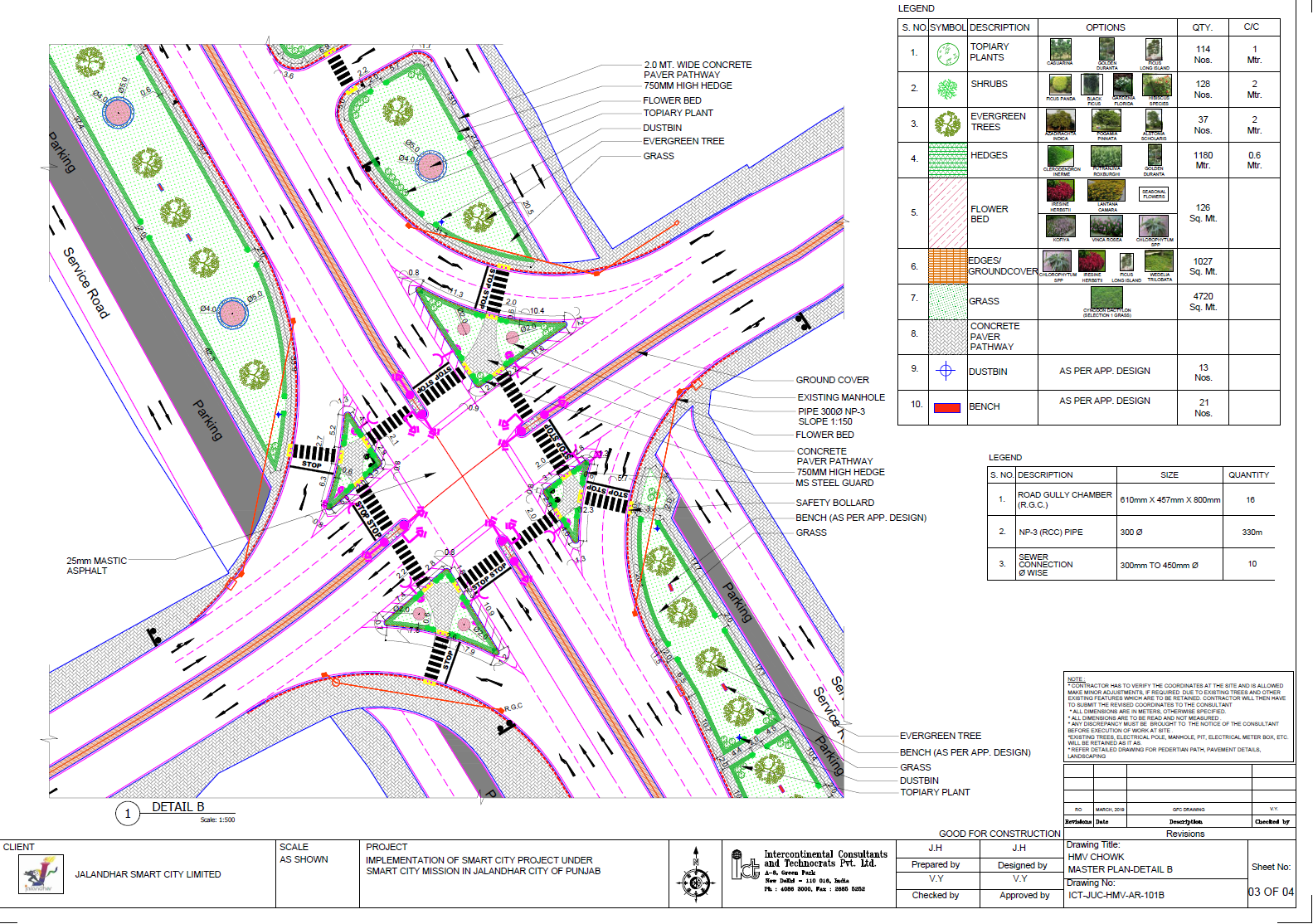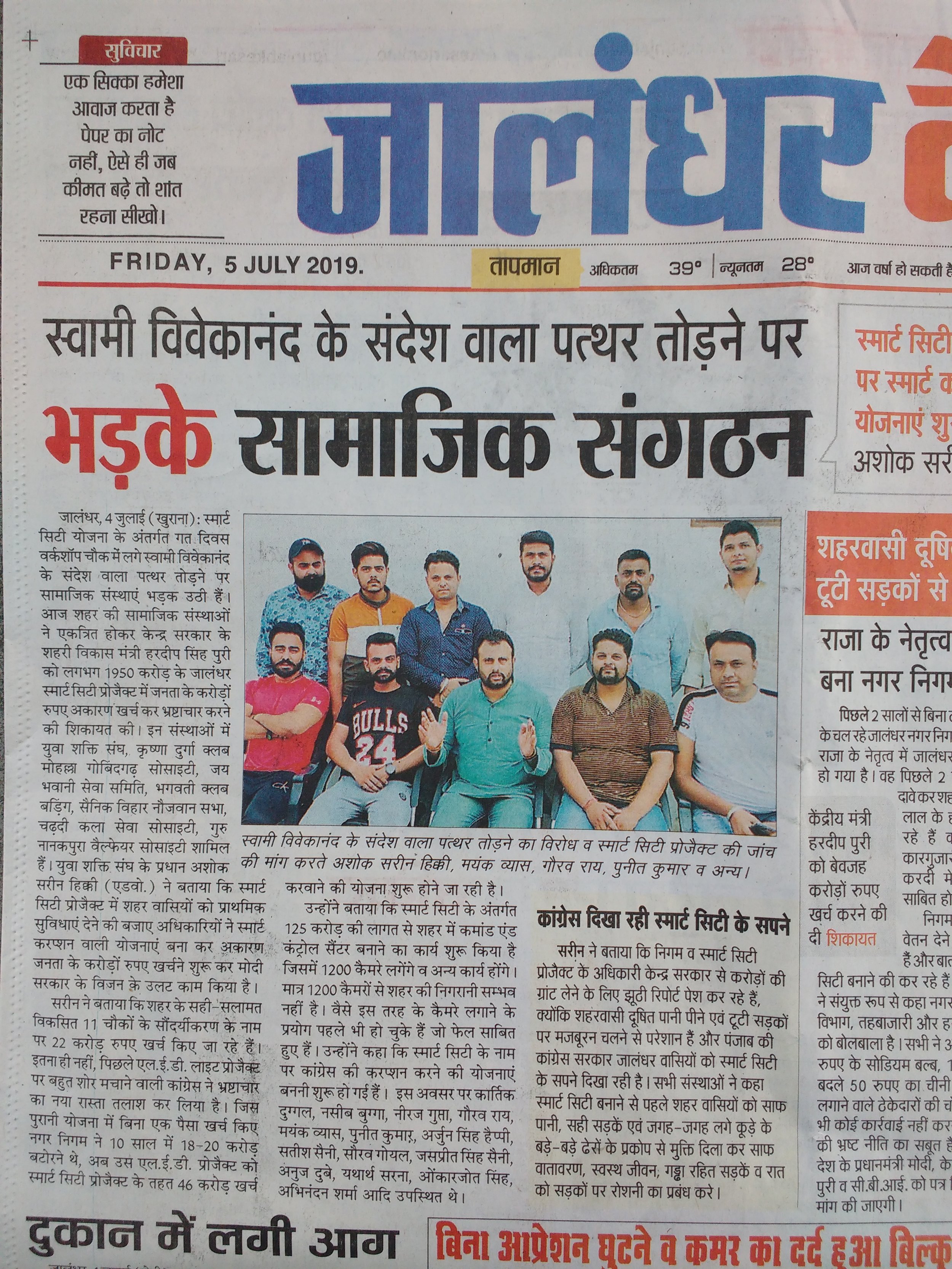Searching for the 'Smart city' in Jalandhar - Part 2
By Varun Patil, Research Assistant
Doob ke jaana hai: Digging up on the traffic junction improvement project aiming to reduce congestion and promote walkability in Jalandhar.
After months of being in Jalandhar tracing the smart city mission on kagaz (paper), news began to trickle in one fine day that finally a smart city project, improvement of existing traffic junctions across the city, has taken off on the ground. Excited, we immediately hail an auto and rush ourselves towards workshop chowk (also known as HMV chowk) at the northern part of the city. It is the season of monsoon and it starts to drizzle. For a moment we think we should cancel our plans and maybe visit the site another day. A more drier day, perhaps. Jalandhar has an extremely poor storm water network and we are told that the city gets flooded in no time (the smart city mission has promised to replace the storm water drain network in the ABD area). But we are too excited by the prospect of seeing the first smart city project taking off and thus march ahead with our plans. As expected the monsoon showers quickly turn the city into a big puddle. Our auto-driver expertly navigates the flooded city making sure that the water does not enter the engine and shut it off. After almost 15 minutes later we finally arrive at the chowk, a busy intersection on the old Grand Trunk road.






As we get down we see that the work on the chowk is still in its very initial stages: the contractor has dug up the earth along the three sides of the intersection, which form three mini islands. One of the island is empty, the other has a peepal tree which is actively worshiped by nearby residents and the third has a Swami Vivekananda statue. The municipal officials have not dug up the fourth island as it is already developed and being maintained by the HMV College. We notice that the contractor in his over enthusiasm seems to have also pulled down a granite slab stone containing the swami’s quote. Due to heavy rains the dug up pits are now covered completely with water, making it dangerous for vehicles passing by. There is no sign board by Jalandhar smart city company limited JSCL or the Jalandhar municipality in form of a board where the details of the project are spelt out properly.
We head to talk to a few vendors around the chowk to get a sense of what is going on. They tell us they are equally clueless. ‘The officials said they want to make the area green, we don’t get it, the chowk is already surrounded by parks in its four sides’ says a vendor who has been working at the intersection from a long time. It starts to drizzle again and take shelter under the chaiwalas tarpaulin.
Though Jalandhar is a smaller city compared to metros like Delhi and Mumbai, traffic congestion has become an important civic issue for several citizens. As the city expanded in the 2000’s the city administration decided to move away from the earlier roundabout (chowk) junction system, a characteristic feature of all cities in the 1980’s and still in Lutyens Delhi and Chandigarh, towards a proper traffic light system. Many roundabouts were reduced and/or removed and the statues inside them placed at one of the corners in the junction.
Under its pan city traffic junction improvement scheme the Jalandhar smart city company hopes it would be able to at least able to address some of the problems of traffic congestion. Eleven major junctions of the city have been selected for the scheme: Guru Nanak Mission Chowk, Nakodar Chowk (BR Ambedkar chowk), Bhagwan valmiki Chowk, Guru amardas Chowk, Guru Ravidas Chowk, HMV College, Kapurthala Chowk, PNB Chowk and Kapurthala road intersection, BMC Chowk, PAP Chowk and, Model Town Intersection. What exactly are the elements of the scheme is not totally clear as the DPR has not yet been made public by the smart city company. Piecing together from various news reports and some interviews with the smart city officials we were able to understand its aims.
Firstly the scheme aims to reduce congestion by installing traffic lights at all the junctions (if not already installed), improving the lane-geometry (two-laning) of the road abutting the roundabouts and installing foot over bridges with escalators wherever practicable. Digital infrastructure like automated traffic management system will also be employed to reduce congestion. A consultant we spoke to was very enthusiastic about introducing synchronized signaling systems or concept of green corridor which he argued saves commuter time and congestion. “Green corridor however works best in western cities as there residence and workplace are separated and you can predict the traffic patterns. Here we have so much mixed land use due to parallel and informal economies that each place is both home and workplace. It will be difficult to run green corridor. However out of the 11 junctions selected, 5 were in a straight line and after integration with ICCC we may try a green corridor here too”. He said they had to rule out the option of flyover and widening of junctions to tackle congestion. “We don’t want land acquisition issues and flyover concept is now being discouraged in west too. You see there is no flyover option in smart city” he noted.
Secondly the scheme aims to promote walking by developing proper and wider footpaths across the junctions. The consultant noted that they will be putting table top crossing at each junction to facilitate pedestrians. Thirdly the scheme also aims to improve safety at the major junctions by installing latest CCTV’s at the chowk so that traffic violators can be caught and the challans can be directly sent to their home. And finally the scheme aims to develop the landscape area around the junctions to improve the aesthetic look of Jalandhar city, an important aim in the smart city mission here.
The junction project was inaugurated hurriedly in March this year before the National elections by the local elected representatives to showcase the developmental works being done in the city before the citizens[1]. However since then it seems to have become mired in troubles. Many civil society groups have critiqued the project for being wasteful by spending 22 crores on what they see is essentially sundarikaran (beatification) of chowks. Though improving the aesthetics of the chowk is only one of its professed aims, the Hindi press has been reporting the project as mainly involving ‘sundarikaran’ (beautification) of chowks. Critics allege that the chowks are already sundar (beautiful) and do not need any more sundarikaran (beautification). One disgruntled citizen told us ‘When I am already wearing good clothes I am being told that my clothes are old and I need to spend on a new one’. ‘It is smart corruption and nothing else’ alleged another activist whom we spoke to. The critics argue that the money should be put into basic development works like sewerage and water supply than ‘improving’ the chowks. A vendor at the workshop chowk where the work has started felt that the redevelopment of this chowk was a complete waste of public money and government should be building houses and colonies for the poor.
Many others feel that the project does not go far enough to address the problem of traffic congestion in the city. A local policemen at the busy Ravidas junction whom we spoke to said he would prefer flyovers rather than re-developing the chowks. He added that in many chowks the police have shut down the traffic signal system as ‘the people do not follow the traffic lights anyway’. He complained that they cannot suggest removing or trimming roundabouts as most of the chowks are now named after Dalit icons and that ‘they would vehemently oppose any such move’. We were told of a massive protest by Dalit organizations when the administration decided to trim the BR Ambedkar chowk a few years ago.
A lot of activists also pointed out to the prevalence of the diesel auto lobby and the failed public bus scheme which is the real cause for traffic congestion. ‘The courts had banned diesel autos from the city. Yet they continue to ply due to the patronage of political leaders. You see just on this small stretch from corporation to Valmiki chowk thousands of auto are plying constantly jamming up the chowk. The administration needs to address that first’ said an activist to us. We were also told that the municipality had few years ago started an ambitious bus service but had mysteriously stopped the scheme and now the vast fleets of buses were standing in the bus stand. A news report notes that around 8,000 people used to travel in the city through city bus service every day earlier[2]. With no public transport available in the city, the traffic infrastructure seems to have taken a toll with around 10 lakh private vehicles plying on the city roads every day[3].
Finally it stops to rain at workshop chowk. As we wrap up our visit and head back to our place we hear that criticism of the first smart city work is already started pouring in fast. A news report in The Tribune, a well-respected paper in Punjab said that the work was being mismanaged severely inconveniencing commuters. ‘Earlier, the commuters were forced to cross the road which had deep potholes but now, the complete roundabout and the roads connected with it are in a pathetic state’ it noted[4]. The popular local paper Punjab Kesari was even more scathing. It rued that “Logo ko asha thi ki smart city mission ke tehat hone wali kaam atyanth smart tarike se hoga, par smart city mission ke tahat chal rahe ye karya, atyanth desi tarike se kiya jar aha hai’ (People had expected that the works carried out under the mission would be executed in a smart manner, but work on the smart city mission is proceeding disappointedly in a very desi (read haphazard) manner)[5].
As the first smart city project finally kicks off on the ground after three long years of waiting it would be a big challenge for the city administration to keep up with the tremendous expectations that the promised urban transformation has released among the citizens and the media. As the ex-Mayor Sunil Jyothi had rightly warned after the city was finally selected in the second round of the mission, “Koi asaan kaam nahi hai yeh smart city banana…ye aag ka dariya hai aur doob ke jaana hai (it is not easy to make the city smart… it is like a sea of fire and one has to dive right through it)[6]”.
Contd. from Part 1 here
Notes
[1] https://www.tribuneindia.com/news/jalandhar/smart-city-project-set-to-begin-in-city/530919.html
[2] https://www.tribuneindia.com/news/jalandhar/city-bus-service-a-distant-dream/215400.html
[3] https://www.tribuneindia.com/news/jalandhar/with-no-public-transport-over-10-lakh-pvt-vehicles-on-city-roads/122458.html
[4] https://www.tribuneindia.com/news/jalandhar/workshop-chowk-in-poor-state/813100.html
[5] https://punjab.punjabkesari.in/jalandhar/news/workshop-chowk-jalandhar-1027873
[6] https://www.youtube.com/watch?time_continue=996&v=fXt42uoGzbg
